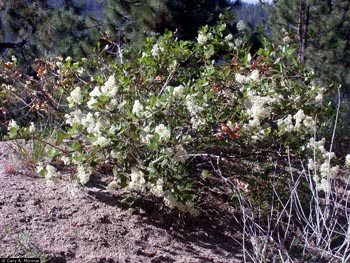Deerbrush

Common Name(s):
Deerbrush
Snowbrush ceanothus
Scientific Name:
Ceanothus velutinus Dougl. Ex Hook.
Scientific Name Synonyms:
None known
Symbol:
CEVI
Description:
Life Span: Perennial
Origin: Native
Season: Evergreen
Growth Characteristics: A 3 to 9 foot tall shrub with a single stem to many stems growing from the base. The stems are loosely branched and spreading, often prostrate. Flowers May to July, fruits mature in August and September, reproduces from seeds. Plants produce a strong cinnamon or balsam-like odor.
Flowers/Inflorescence: Flowers are in dense, white, showy clusters at the ends of the branches. They are small and numerous. Each flower has 5 white, triangular sepals which curve sharply between the petals over the flowers. Has 5 white, pipe-shaped petals, usually curved downward.
Fruits/Seeds: Fruits are a sticky glandular capsule, which separates into 3 carpels, each with 1 seed. Each lobe has a blister-like keel. Seeds are shiny and tan to dark brown.
Leaves: Alternate, large, broadly oval shaped, with a serrated margin. Each leaf is distinctly 3-veined from the base. The top of the leaf is dark green, leathery, with a varnished appearance. The underside of the leaf is pale with some hair.
Stems: Twigs rigid, slightly flattened, slightly hairy, and olive green. The bark is reddish-brown.
Ecological Adaptions:
Deerbrush grows on dry rocky hillsides, on mountain slopes, and in steep canyons at elevations between 6,200 and 13,000 feet. It is shade intolerant and generally grows on sunny, exposed sites. Deerbrush can grow as scattered individuals or patches in open woodlands but forms dense, extensive, nearly impenetrable stands on disturbed sites. This is due to its capability to sprout vigorously after disturbance. The roots are capable of nitrogen fixation.
Soils: Deerbrush grows well on a variety of dry, rocky, well-drained soils. Soils tend to be moderately acidic to neutral. Most abundant on logged or burned areas.
Associated Species: Big sagebrush, aspen, mountain brome, and chokecherry, Englemann spruce, and subalpine fir.
Uses and Management:
Deerbrush provides food and cover for a wide variety of wildlife species. It is eaten seasonally by elk, but is of primary value during the winter. Deer feed on this shrub year-round where preferred forage is scarce, but it is generally of primary importance during winter. Deerbrush is an important fall and winter moose browse in many parts of the Intermountain region. Fruits and seeds of deerbrush are eaten by small mammals, and birds. All types of wildlife use it for cover and areas to bed down.
Deerbrush is worthless to cattle and of very slight importance to horses. It has poor forage value for domestic sheep. Use of deerbrush by domestic sheep may indicate overgrazing. Annual utilization of no more than 35 to 40 percent has been recommended for this shrub.
Some American Indians used the leaves of deerbrush as a tobacco substitute. The leaves contain sapopin and were used to make soaps and cleaners.

